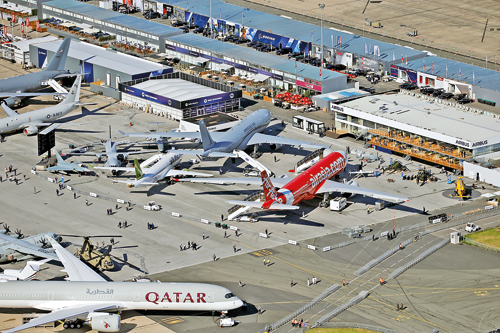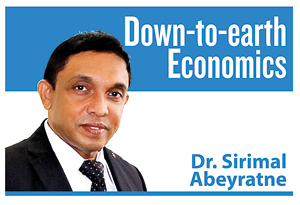Fight on the flight
View(s):
An aerial view shows Airbus airplanes next to other airplanes during the 53rd International Paris Air Show at Le Bourget Airport near Paris, France, June 17, 2019. Picture taken June 17, 2019. REUTERS/Pascal Rossignol
On October 6, 2004, the US commercial aircraft manufacturer – Boeing, made a complaint at the World Trade Organisation (WTO). The complaint was against its competitor – Airbus, on the receipt of “subsidies” from the European Union (EU).
What was wrong with giving subsidies to Airbus Company by EU governments? And why on earth was Boeing furious about it?
There was other exciting news which would make our story even more interesting today. On the same day, Airbus – the EU commercial aircraft manufacturer, also went to the WTO, and made a complaint against its competitor – Boeing. The complaint was on the receipt of “subsidies” by Boeing Company from the US government.
It is interesting as to how the world’s two large commercial aircraft (LCA) manufacturers – Airbus and Boeing, became both the complainer and the respondent against each other on the same day on the same cause! And the questions that we raised above are equally valid for both sides.
Free and fair
The Airbus – Boeing dispute has been the world’s biggest and, perhaps, the most costly trade dispute at the WTO. When there are trade disputes between the WTO-member countries, they can file the cases at the WTO.
The WTO which has the mandate to promote “free and fair trade in the world” carries out investigations to reach dispute-settlements or to permit “countervailing” measures. In fact, the WTO role is more for lawyers than for economists so that it is basically an organisation with lawyers.
By the principles of free and fair trade, both “dumping exports” and “subsidising exports” are equally bad! There are 1000s of trade dispute cases reported to the WTO. It was the rich countries that initiated the most number of dispute cases initially. But now China, India and many other developing countries are also leading the race of dispute cases.
Dumping and export subsidies
A country can “dump” exports in another country by exporting goods at a price lower than the cost of production, affecting adversely the domestic production. I must note that it is not an easy task to investigate and prove these facts, if a country decides to file a case at the WTO against “dumping” by another country.
The point is that the same is true if a country is providing “subsidies” to an exporting firm. The subsidy will lower the price of the exported commodity so that it will also result in the same negative effects in the importing country. Just like dumping, it will also cause injury to domestic producers.
If a country can prove that government subsidies in an exporting country have injured domestic production due to lower price, then it is a case to be filed at the WTO. This was exactly the point for both Airbus and Boeing companies to complain against each other. But there is more to add to the story of the Airbus-Boeing dispute.
Intense competition
The world’s large commercial aircraft (LCA) manufacturing industry has been a “duopoly” – a market structure, dominated by two major players: EU-based Airbus and US-based Boeing. They have been engaged in intense competition to protect their market share, which can easily be taken over by the other rival.
We are talking about an industry with annual turnover counted in billions of dollars and about 300,000 employees. One unit of wide-body aircraft such as A380 and A350 from Airbus or 747-8 and 777X-9 from Boeing, which can be configured to accommodate 400 – 600 passengers is sold at more than US$ 400 million.
The world market is almost equally shared by the two rival companies: It was reported that during the period of 10 years from 2007-2016, Airbus has received over 9,900 orders and, Boeing little less than 9,000 orders.
Risky game and “launch aid”
There is growing demand for aircrafts from all over the world and, that demand is also for newer models too. As a result, both Airbus and Boeing are keen in investing in R&D worth billions of dollars to launch a new model.
And, here is the risk and uncertainty associated with R&D spending on launching a new model: For example, if Airbus spends on R&D, Boeing is faced with the risk of losing the “entire” market share, while Airbus itself is faced with the risk of losing its R&D spending. The world demand might divert towards Airbus causing losses to Boeing. If it doesn’t happen, of course, Airbus itself would have wasted its “entire” R&D spending.
At least just to protect the market share if not for an increase, Boeing has to respond in spending for R&D to bring out a new model to compete with Airbus.
This action-reaction process is a risky game. They may not put themselves into that risk without external subsidy – the so-called “launch aid”. This is where the problem is: While Boeing receives launch aid from the US government, Airbus receives it from the EU governments. They both have accused each other for receiving “illegal” subsidies over US$ 20 billion for launch aid from the respective governments.
Honouring the agreements
Although they had agreements not to do so, they both are suspicious of “honouring” the agreements by the other party.
An important issue is that although subsidies granted directly can be easily accounted for, there are issues with granting “hidden” subsidies. These include various tactics such as tax breaks, cheap credits, over-estimated deals through government contracts and procurements, and grants through some other agencies.
Subsidies are good for the consumers, however. Without launch aid from their respective governments, neither Airbus nor Boeing is likely to take a billion-dollar worth risk. It is because of the government subsidy from tax money that the world market gets new models of aircraft.
Emerging third player
The biggest challenge to both Airbus and Boeing now is not their own dispute, but the potential break-up of their “duopoly” market with an emerging third player: China. The Commercial Aircraft Corporation (Comac) of China recently launched its first large commercial aircraft – C919 for test flights.
 The medium-size Comac C919 has seating capacity for 160 passengers and, is likely to compete with Boeing 737Max and Airbus A320 models. After a few years of testing, Comac C919 aircraft will be in the market snatching a significant part of the world’s commercial aircraft market. According to the reports, it has already received nearly 1,000 orders, while most of them are from China’s own airlines.
The medium-size Comac C919 has seating capacity for 160 passengers and, is likely to compete with Boeing 737Max and Airbus A320 models. After a few years of testing, Comac C919 aircraft will be in the market snatching a significant part of the world’s commercial aircraft market. According to the reports, it has already received nearly 1,000 orders, while most of them are from China’s own airlines.
China was so far the biggest buyer of aircrafts in the world so that the emerging Comac is not only going to compete in the commercial aircraft industry, but also capture the biggest Chinese market. It has been estimated that China with a fast-growing travel and transport sector needs 3,200 aircraft within the next 10 years.
Here is the new turn for Airbus-Boeing dispute at WTO. Chinese Comac as well as Chinese airlines are all State-Owned Enterprises (SOEs). The new market structures emerging in China and challenging the industry is entirely a different one.
Against the prospective
customer
SOEs is not a new thing in China, and all big businesses in China are public enterprises. Average size of the Chinese SOEs is much bigger than the size of non-SOEs in China. In fact, some of them have become the world’s biggest multinational corporations too. And after all, how the state subsidises and supports China’s own SOEs is an internal matter of the Chinese government.
There is, however, a point. If the government subsidy or support systems can result in an injury to competing businesses from other countries, they have a case for going to WTO against China.
Already, at the WTO the US has filed 23 cases, and the EU 9 cases against China. Perhaps, the two aircraft-making rivals – Airbus and Boeing -, might get together holding each other’s hands at the WTO to file a new case against Comac for injuring their businesses.
(The writer is a Professor of Economics at the University of Colombo and can be reached at sirimal@econ.cmb.ac.lk).


